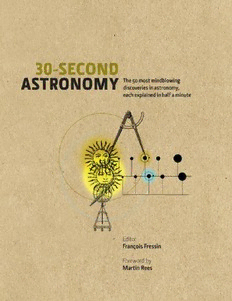
Martin Rees Francois Fressin 30-second astronomy the 50 most mindblowing discoveries in astronomy each explained in half a minute Icon Books Ltd (2013) PDF
Preview Martin Rees Francois Fressin 30-second astronomy the 50 most mindblowing discoveries in astronomy each explained in half a minute Icon Books Ltd (2013)
30-SECOND ASTRONOMY The 50 most mindblowing discoveries in astronomy, each explained in half a minute Editor François Fressin Foreword by Martin Rees Contributors Darren Baskill Zachory K. Berta Carolin Crawford Andy Fabian François Fressin Paul Murdin First published in the UK in 2013 by Icon Books Omnibus Business Centre 39–41 North Road London N7 9DP email: [email protected] www.iconbooks.net © 2013 by Ivy Press Limited The editor and contributors have asserted their moral rights. No part of this book may be reproduced in any form, or by any means, without prior permission in writing from the publisher. This book was conceived, designed and produced by Ivy Press 210 High Street, Lewes, East Sussex BN7 2NS, UK www.ivypress.co.uk Creative Director Peter Bridgewater Publisher Jason Hook Editorial Director Caroline Earle Art Director Michael Whitehead Designer Ginny Zeal Illustrator Ivan Hissey Profiles Text Viv Croot Glossaries Text Charles Phillips Project Editor Stephanie Evans ISBN: 978-1-84831-597-6 Colour origination by Ivy Press Reprographics 10 9 8 7 6 5 4 3 2 1 CONTENTS Foreword Introduction The Planets GLOSSARY Mercury Venus The Earth The Moon Mars Jupiter Profile: Galileo Saturn Uranus & Neptune The Solar System GLOSSARY The Sun The Solar Wind Eris, Pluto & Dwarf Planets Asteroids Profile: Copernicus Comets Meteors The Stars GLOSSARY Colour & Brightness of Stars Binary Stars Variable Stars Giant Stars White Dwarfs Pulsars Profile: Jocelyn Bell Burnell Supernovae Black Holes The Milky Way GLOSSARY Constellations Molecular Clouds & Nebulae Messier Objects The Milky Way Profile: William Herschel The Other Galaxies Galactic Structures The Universe GLOSSARY The Big Bang The Expanding Universe Profile: Edwin Hubble Cosmic Microwave Background Beyond Visible Light Cosmic X-Rays Gamma Ray Bursts Quasars Dark Matter Dark Energy Space & Time GLOSSARY Light-Years & Parsecs Ellipses & Orbits The Light Spectrum Gravity Relativity Gravitational Lensing Profile: Fritz Zwicky Wormholes Other Worlds GLOSSARY Extraterrestrials Profile: Carl Sagan Exoplanets Hot Jupiters Super-Earths & Ocean Planets Towards Another Earth Evidence for Other Life APPENDICES Resources Notes on Contributors Index Acknowledgements FOREWORD Martin Rees The night sky is the most universal part of our environment. Throughout history, people have gazed up at the same ‘vault of heaven’, though each culture has interpreted it in its own way. Ever since the Babylonians, patterns have been recorded in planetary motions. The need for a precise calendar, and for navigation across the oceans, has motivated advances in timekeeping, optics and mathematics. Indeed, astronomy has always been a driver for technology. And, thanks to huge telescopes, probes and advanced computers, modern astronomers have discovered the amazing cosmic panorama described in this book. Theorists like myself lag far behind in trying to make sense of it all. But we have made progress. We can trace cosmic history back to a mysterious beginning nearly 14 billion years ago, when everything was squeezed hotter and denser than anything that can be created in a laboratory; we understand in outline how the first atoms, stars and galaxies emerged. We realize that our Sun is a typical star among the billions in our Galaxy; and that our Galaxy is just one of many billions visible through a large telescope. Moreover, some theorists speculate that a further ‘Copernican demotion’ may lie ahead: physical reality is almost certainly more extensive than the domain we can observe; indeed ‘our’ Big Bang could be just one of many. But recent advances haven’t just extended our cosmic horizons: they have revealed richer detail. Probes to other planets of our solar system (and their moons) have beamed back images of varied and distinctive worlds. More important still, we’ve inferred, by detecting very slight changes in the motions and brightness of stars, that most of them are orbited by retinues of planets, just as the Earth and other familiar planets orbit the Sun. In coming years, we will be swamped by fascinating new data – perhaps even evidence of life around other stars. Astronomy now attracts wider interest than ever before – its discoveries are part of modern culture. Moreover, the joy of discovery isn’t now limited to professionals — indeed they are swamped by the sheer quantity of data. So there is scope for ‘citizen scientists’, who can access and download data from surveys made with the world’s best telescopes, and perhaps discover a new galaxy or a new planet. And serious amateurs, using small telescopes with the latest instrumentation, can match what professionals with much larger telescopes could do 50 years ago. Our brightest neighbour Planet Venus is very visible, partly because sunlight is easily reflected by the sulphurous clouds that blanket its atmosphere. Venus is the closest planet to our Earth, within reach of questing space probes, although its hot, deadly atmosphere prohibits any human exploration of its surface. The technical details of all modern science are arcane. However, I believe that the essence of any discovery can be conveyed in accessible language. To condense a concept into 30 seconds is a bigger challenge, but one that has been triumphantly met by the authors here. This book deserves wide readership among those fascinated by the extraordinary ‘zoo’ of objects in the cosmos – a cosmos governed by physical laws that allowed creatures to evolve (on Earth and perhaps on alien worlds too) with minds able to ponder its wonder and its mystery.
